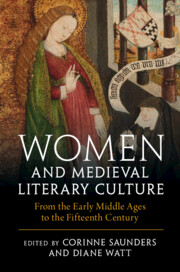Book contents
- Women and Medieval Literary Culture
- Women and Medieval Literary Culture
- Copyright page
- Contents
- Illustrations
- Contributors
- Acknowledgements
- Introduction
- I Patrons, Owners, Writers, and Readers in England and Europe
- II Circles and Communities in England
- III Health, Conduct, and Knowledge
- Chapter 7 Embracing the Body and the Soul
- Chapter 8 Gender and Class in the Circulation of Conduct Books
- Chapter 9 Women’s Learning and Lore
- Chapter 10 Women and Devotional Compilations
- IV Genre and Gender
- V Women as Authors
- General Index
- Index of Manuscripts
- References
Chapter 9 - Women’s Learning and Lore
Magic, Recipes, and Folk Belief
from III - Health, Conduct, and Knowledge
Published online by Cambridge University Press: 28 July 2023
- Women and Medieval Literary Culture
- Women and Medieval Literary Culture
- Copyright page
- Contents
- Illustrations
- Contributors
- Acknowledgements
- Introduction
- I Patrons, Owners, Writers, and Readers in England and Europe
- II Circles and Communities in England
- III Health, Conduct, and Knowledge
- Chapter 7 Embracing the Body and the Soul
- Chapter 8 Gender and Class in the Circulation of Conduct Books
- Chapter 9 Women’s Learning and Lore
- Chapter 10 Women and Devotional Compilations
- IV Genre and Gender
- V Women as Authors
- General Index
- Index of Manuscripts
- References
Summary
Starting with the early Middle Ages and offering a broad survey through to the start of the early modern period, this essay examines a range of charms, incantations, prayers, talismans, amulets, recipes, and remedies. Many of these were certainly used for women and sometimes by women, such as charms on birthing scrolls or girdles. The analysis reveals the unexpectedly wide range of areas of expertise ascribed to medieval women, as is illustrated by Christine de Pizanߣs writings on warcraft and chivalry, and the guide to hunting, hawking and heraldry attributed to Dame Juliana Berners (The Book of St Albans). Finally, the essay looks at the extremely varied and encyclopaedic advice available to women found in the compendium known as The Kalender of Shepherds (c. 1490), an important source of folk belief, demonstrating the diversity of medieval womenߣs lore.
Keywords
- Type
- Chapter
- Information
- Women and Medieval Literary CultureFrom the Early Middle Ages to the Fifteenth Century, pp. 179 - 205Publisher: Cambridge University PressPrint publication year: 2023



